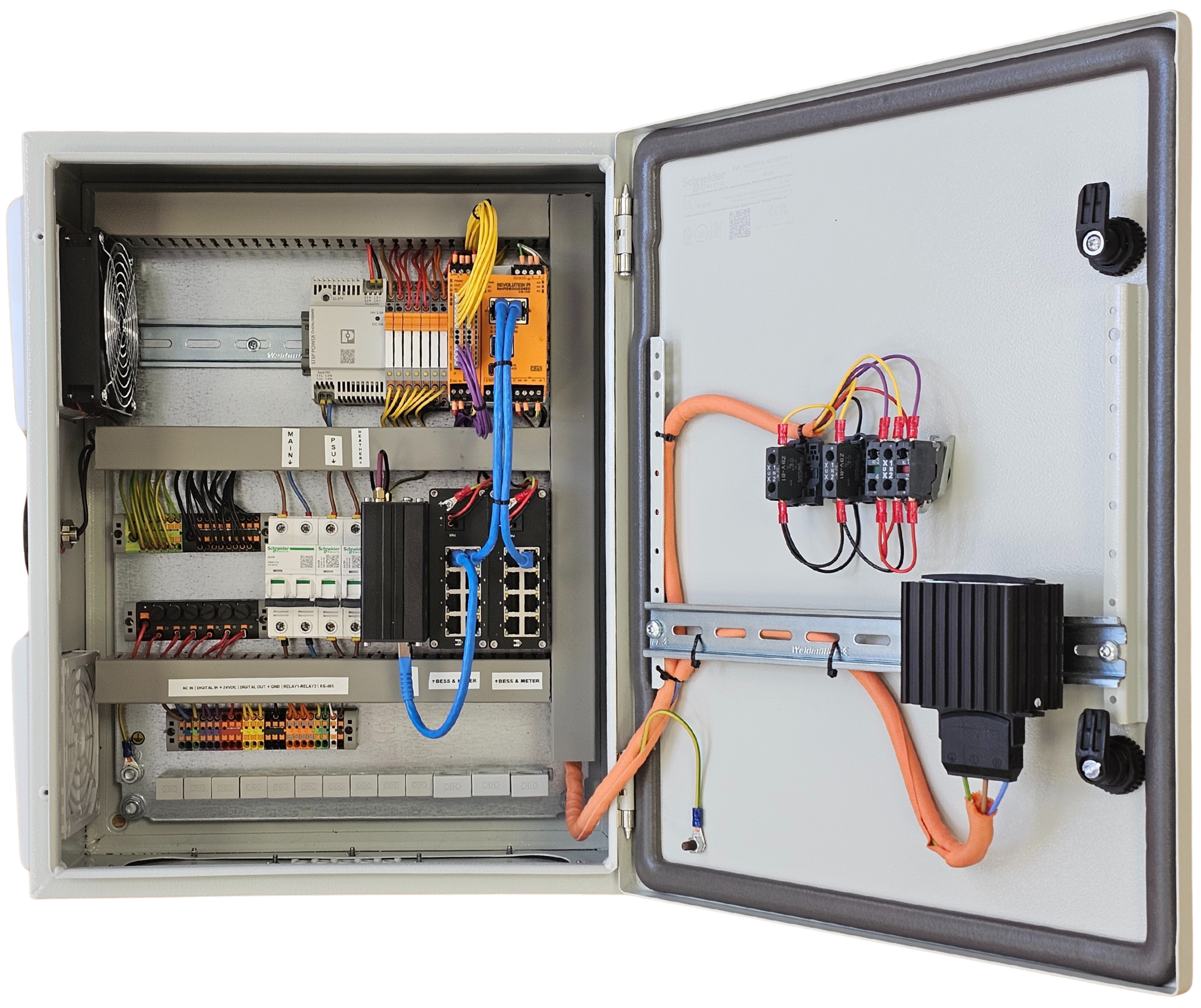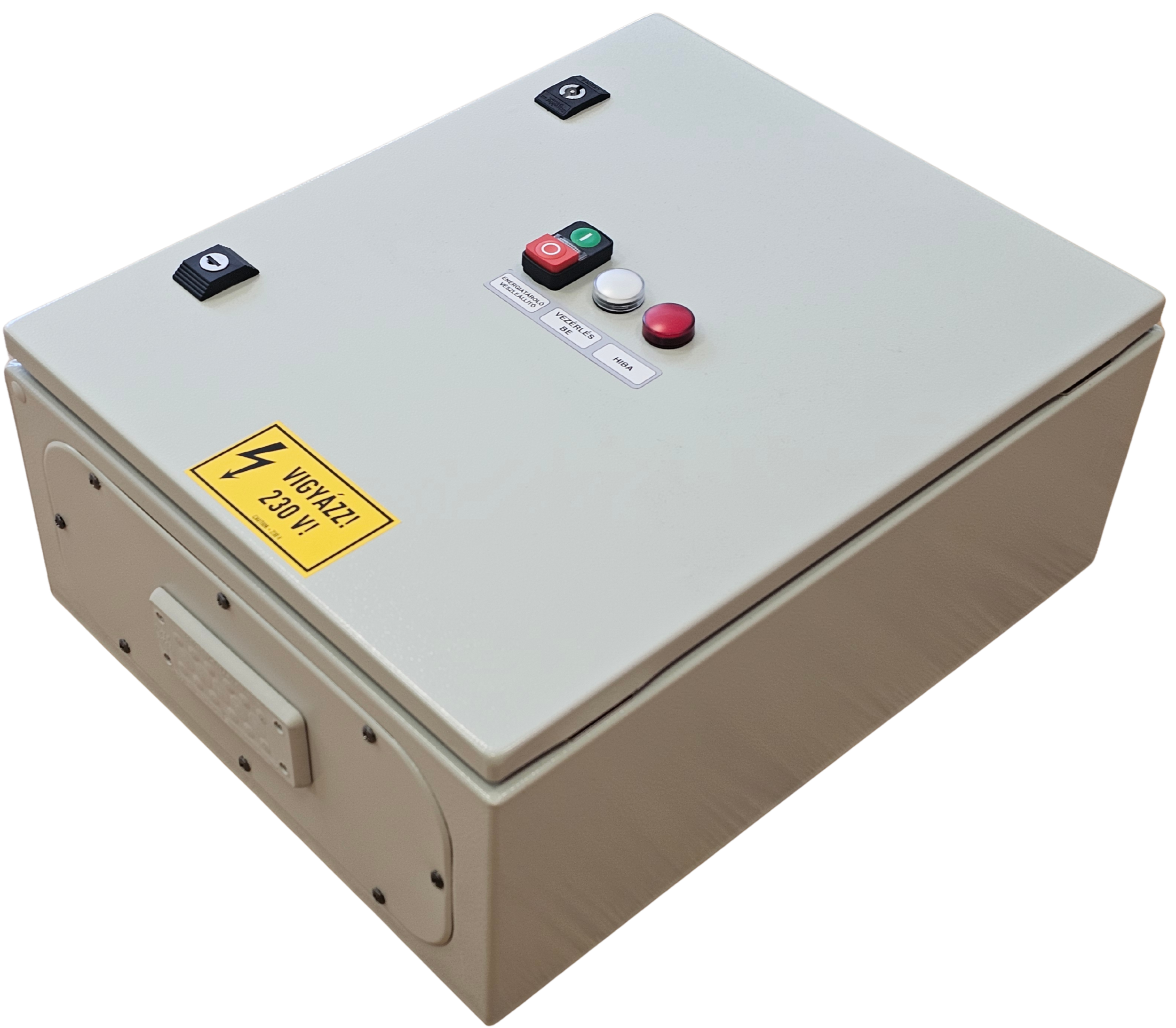Control cabinet - M
Local control functions
-
One of the disadvantages of solar PV systems with backwatts protection is that they can only produce energy when it is needed immediately. If there is no immediate use, the system will regulate itself back, resulting in production fluctuations and lower efficiency. As a consequence, the self-consumption rate remains low.
The control solution we offer is able to direct the solar energy generated to the battery, taking into account local conditions. This allows the system to operate continuously and in a balanced way, while significantly increasing the self-consumption rate and making much more efficient use of the renewable energy source.
-
In some industrial systems, it is a fundamental requirement that neither the energy from solar generation nor from battery storage is fed back into the public grid. The EMS control unit continuously monitors the operation of the entire system and dynamically controls the equipment based on the data from the energy meters. This means that the energy generated is always used for local consumption, while the possibility of feeding energy back to the grid is completely eliminated.
-
This feature offers a particular advantage where the available network capacity is insufficient or it would be uneconomic to pay higher charges due to short-time power peaks. By including energy storage, the system is able to balance the load, ensuring continuous and stable operation while avoiding costly network expansion. A good example of this is the support of electric vehicle charging stations: the storage dynamically boosts charging when grid power alone is insufficient, so that charging remains reliable and continuous without the need to tie up unnecessary extra capacity.
-
For spot-priced energy contracts, it is of paramount importance to manage intraday price fluctuations consciously. Every day, our energy management system automatically retrieves the next day's exchange electricity prices, identifies the trough and peak periods and then generates a schedule based on these. Accordingly, during the cheaper hours, the system charges the battery from the grid, so that during the more expensive peak periods, internal consumption can be covered by energy already stored. This will allow significant cost savings without having to change consumption patterns.
-
Our system can receive control signals from aggregators via the most common industrial communication protocols and execute them locally in real time. It efficiently supports the control not only of energy storage but also of gas engines and solar farms. In addition to external commands, the built-in local control continuously monitors critical requirements such as back-feed protection or grid capacity limit compliance. This ensures that the external and local control is always coordinated and safe.
-
Equipment connected to the control cabinet can be flexibly controlled via digital inputs, outputs and relays. Based on individual logics, automated control of different consumers or process elements can be implemented. For example, a hot water production system or a cooling compressor can be automatically switched on in case of solar surplus. Another practical example is when it is necessary to trip or automatically reset a motor circuit breaker or to read back its current status.
Technical Specifications
| General information | |
|---|---|
| Rated AC voltage | 230 Vac / 0.5 A |
| Connections | 1 WAN RJ45 port 6 LAN RJ45 ports with internet access (internet switch) 7 LAN RJ45 ports for controlled devices (protected intranet switch) 1 RS-485 port with line interface 3 ports with port connectors 3 ports for line terminal output 2 ports relay output 1 pigtail AC power supply |
| Uninterruptible Power Supply (UPS) | not |
| 4G LTE data connection | yes (2 SIM slots, 1 SIM card included) |
| Internal data connection to controlled devices | Modbus TCP/IP, Modbus RTU |
| External data connection for remote control | MQTT, REST API, Modbus TCP/IP (+VPN option) |
| Controls and feedback | Stop button Feedback LEDs: system status, controller status, fault status Remote monitoring: remote setting of operating parameters, viewing of operating data |
| Dimensions and weight | 500 x 400 x 200 mm, ~14 kg |
| IP protection and material | IP54, Sheet steel, RAL 7035 |
| Operating temperature | -25 - 45 °C (active ventilation, cabinet heating) |
| Location | Indoors or outdoors, wall mounted (mounting tabs included) |
| Guarantee | 1 year warranty |
| Certificates | The control cabinet has CE declaration of conformity (EN 61439-1/2, EN 60529, HD 60364-4-41, EN 61140), the built-in components are CE and have the appropriate certificates and are integrated according to the manufacturers' specifications. |
Control cabinet - M hardware functions
Compact design, robust construction - Designed for industrial use
The outdoor control cabinet contains all the necessary sub-assemblies in a single, compact design: industrial control unit, 4G router, switch, controls, digital I/O and relay outputs. For reliable operation, the cabinet is equipped with active fan cooling and heating to prevent internal condensation. Thanks to external mounting lugs, it can be quickly and easily installed directly in the environment of the controlled system.
4G router and external antenna
A 4G router integrated in the cabinet provides access to the device even where a wired internet connection is not available. Thanks to its special switchover function, it automatically switches to mobile internet within 15 seconds in the event of a network failure, and then switches back to the primary source once the main network (Ethernet WAN) is restored.
The router has two SIM slots: one for the user's own SIM card, and the other - provided by us - for emergency use. The latter allows us to provide remote assistance and access to the device configuration in the event of a network outage.
Dual switch: internet + intranet
The control cabinet has two separate switches that provide secure and flexible network connectivity. The internet switch is used for external data connectivity, for example for remote monitoring, data transmission, cloud services. As an option, controlled devices can also be connected to this switch, giving them direct access to the Internet to access their own monitoring system or to update software.
An intranet switch, on the other hand, offers a fully isolated, protected internal network. If the controlled devices are connected to this switch, they do not have access to the Internet, so a higher level of security can be achieved. This is particularly advantageous in environments where network policy strictly limits Internet access for devices connected to the internal network.
Separating the two networks ensures that local management can operate securely and seamlessly, while retaining the flexibility to provide internet access on demand.
Network watchdog (reboot)
The control unit continuously monitors its own operation and if any process freezes, it will reboot itself by hardware. The same applies to the router and the switch: if the connection is permanently lost, the watchdog function implemented in the control unit automatically cuts the power to the device and then turns it back on. This means that the system is very likely to recover autonomously, avoiding unnecessary outages for remote systems and ensuring that operation can be resumed quickly.
Stop button, indicator LEDs
The stop button on the control cabinet door can be used to shut down the storage or solar system or the automatic operation by software and restart it if necessary. Built-in indicator LEDs provide immediate status information: the white LED indicates that the control is running continuously, while the red LED lights up if a fault occurs on any of the monitored equipment. This solution provides operators with quick and clear information about the system's operation.
Digital IO, relay outputs
The digital inputs and outputs of the cabinet, as well as the relay outputs, allow direct control and status feedback of various devices. The interfaces, operating at 24V, provide easy and reliable integration with industrial consumers, control cabinets or safety components. The system can thus be flexibly adapted to local needs, be it switching tasks, start/stop or receiving status signals.



